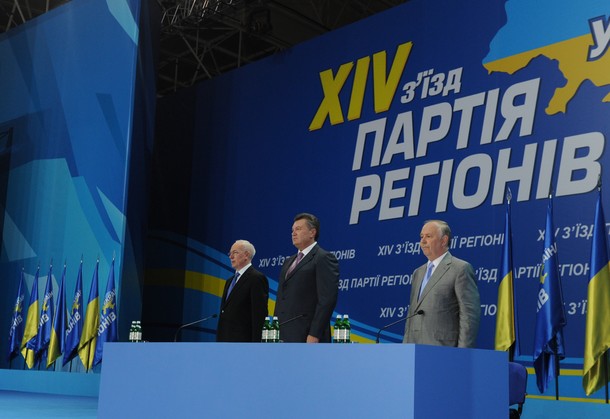
Eight Reasons Why Ukraine’s Party of Regions Will Win the 2012 Elections
Publication: Eurasia Daily Monitor Volume: 9 Issue: 189
By:

Opinion polls have shown a gradual growth of support for the Party of Regions ahead of the October 28 parliamentary elections, which will give them a plurality in the legislature. The United Opposition (Fatherland and Front for Change—UO) and Ukrainian Democratic Alliance for Reforms (UDAR) are vying for second and third place, respectively, in the proportional half of the elections.
The Party of Regions will receive support from its Communist Party (KPU) allies who are guaranteed to enter parliament. The nationalist Freedom Party, which has agreed to form a coalition with the UO and UDAR, may just cross the five-percent threshold (https://www.ratinggroup.com.ua/upload/files/RG_politicalUA_102012.pdf).
Why the ruling Party of Regions should be in first place is surprising as the Mykola Azarov government has undertaken more unpopular IMF policies than the 2007–2010 Yulia Tymoshenko government—although not everything the IMF has demanded. The Azarov government has introduced one round of utility price increases to reduce gas subsidies to households and raised the pension age for women.
There are eight explanations for the electoral success of the Party of Regions.
History: In both the Soviet and post-Soviet eras, Ukraine has been ruled by eastern Ukrainian leaders and political forces. The only exception to the rule was western Ukrainian Leonid Kravchuk, president in 1991–1994. Viktor Yushchenko, president from 2005 to 2010, is from Sumy and is an eastern Ukrainian with a western Ukrainian ideology.
In the last two decades, the most successful parties in elections have been the KPU (1994–1998) and Party of Regions (since 2006), both of which have strong regional bases of support in Ukraine’s East. National democratic parties have only received a plurality once in 2002.
Eastern Ukrainian elites believe they, who represent the industrialized and urbanized regions of Ukraine, have a right to rule Ukraine—and not elites from the rural and less populated western Ukraine. The seven oblasts of western Ukraine only account for 12 percent of the country’s GDP, which is less than the city of Kyiv (18 percent). Slovakia and Belarus have similar populations to western Ukraine but six to seven times larger GDPs. Western Ukraine is kept afloat by remittances sent from the EU (https://www.epravda.com.ua/columns/2012/09/13/335089/). History also explains two other factors.
Firstly, the Party of Regions and KPU can rely on a stable core of a third of the electorate, which will vote for them regardless of their policies. Western Ukrainian voters withdraw their support if they feel their leaders (Yushchenko) or parties (Our Ukraine) have betrayed them.
Secondly, surveys show that Ukrainians believe political stability and the economy are as important as democracy, and these voters are more likely to vote for the Party of Regions and the KPU. More Ukrainians support their country’s membership in the CIS Customs Union than the EU, while NATO membership is now a dead question (see EDM, July 7, 2010). Between 24 and 29 percent of UO, UDAR and even Freedom Party voters support membership in the CIS Customs Union (www.dif-org.ua, October 1).
Political Machine: The Party of Regions, which has never received any training or other forms of support from Western foundations, is Ukraine’s only political machine. The closest equivalent on the opposition side was Tymoshenko by virtue of her charisma, self-confidence and determination.
In both the 2007 and 2010 elections, Tymoshenko narrowly lost to Viktor Yanukovych by three percentage points, and she was the only national democratic political force to win votes in Russophone Ukraine. Not surprising therefore, Tymoshenko is the only democratic opposition leader whom Yanukovych fears. As pre-election polls show, UO leader Arseniy Yatsenyuk is unable to mobilize voters in the same manner.
Most national democratic parties are led from the top down and rely on charismatic leaders for popularity. The Party of Regions has had three leaders—Azarov (2001 and since 2010), Volodymyr Semynozhenko (2001–2003) and Yanukovych (2003–2010). Election mistakes and failures do not lead to leadership changes; leaders see parties as their personal fiefdoms and block internal democracy (Ukrayinska Pravda, August 6).
Monopoly of Power: The Party of Regions holds a monopoly of power in Russophone eastern and southern Ukraine where the KPU is a Party of Regions satellite and voters fluidly switch back and forth between both parties. The KPU has doubled its support from five to over ten percent since the 2006 and 2007 elections because some of its voters have returned from the Party of Regions.
United: The Party of Regions began as a merger of five parties, and has since absorbed another four (New Generation of Ukraine, New Democratic, Republican Party, Strong Ukraine) and co-opted six more (Christian Democratic Party, People’s Party, Party of Industrialists and Entrepreneurs, United Center, Chernovetskyy bloc, KPU). The Party of Regions is therefore a coalition of interests and groups.
All told, a total of fifteen parties, including four of the five parties in President Kuchma’s For a United Ukraine 2002 election bloc, receive support from Yanukovych’s party. Oligarchs with close ties to Yanukovych have also provided financial assistance to UDAR (Dmytro Firtash, Igor Kolomoyskyy) and Forward Ukraine! (Rinat Akhmetov), thus undermining their role as a genuine opposition (Ukayinska Pravda, September 7, 10; Kyiv Post, September 20).
Authoritarian: The Party of Regions is an authoritarian party that emerged from working class Donetsk and the violent transition of the 1990s. The greatest willingness to use violence in Ukrainian politics has come from the Party of Regions—not from western Ukrainian nationalists such as the Freedom party (https://www.kyivpost.com/opinion/op-ed/russian-soviet-nationalism-is-the-biggest-threat-t-121480.html). A greater proportion of Party of Regions voters hold anti-democratic views than Freedom party voters (www.dif-org.ua, October 1).
Disciplined: In parliament the only defections have been from the opposition to eastern Ukrainian presidents Kuchma and Yanukovych. The ruling party’s greater access to financial resources is a factor here, but so is a legacy of Communist Party discipline that exists in eastern but not in fractured western Ukrainian parties. Among those parliamentary deputies elected in 2012 in single mandate districts, political corruption will likely encourage them to join the Party of Regions and KPU in a parliamentary coalition (Jamestown Foundation Blog, February 21).
Nationalism: In terms of their structure and political outlook, the Party of Regions is analogous to United Russia, and the virtual “opposition” KPU is the equivalent of the equally virtual Just Russia party (though it should be noted that Ukraine’s regional and linguistic diversity means the country is vastly different to Russia). The Party of Regions and United Russia share anti-Western, statist and economic nationalist political cultures.
Financial: With the majority of Ukraine’s business elites either supporting the Party of Regions from the onset through the Donetsk clan (see EDM, November 4, 2011) or since 2001 through absorption and co-option, it is not surprising there is no level playing field in elections. In addition, the Yanukovych administration—unlike Kuchma—has adopted “Putinist” policies of blocking business support to the opposition. With all political parties funded by big business, the withdrawal of their financial support dramatically reduces the effectiveness of democratic parties (Kyiv Post, June 8).
Consequently, the Party of Regions will, in all likelihood, control a parliamentary coalition ahead of the 2015 presidential elections, and removing this political machine from power will be a difficult task for the democratic opposition.




